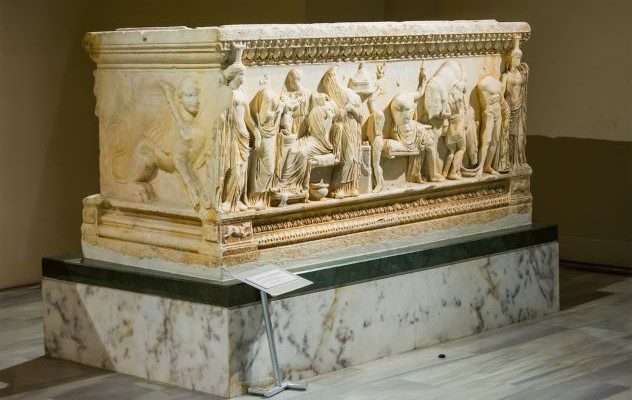 Mysteries
Mysteries  Mysteries
Mysteries  History
History 10 Surprising Stories About the Texas Rangers
 Humans
Humans 10 Philosophers Who Were Driven Mad by Their Own Theories
 Miscellaneous
Miscellaneous 10 Video-Game-Worthy Weapons and Armors from History
 Weird Stuff
Weird Stuff 10 Psychics Who Accurately Predicted Wartime Events
 The Arts
The Arts 10 Pieces of Art Inspired by a Broken Heart
 Health
Health 10 Science Fiction-Sounding New Medical Treatments
 History
History 10 Surprising Facts About the Father of Submarine Warfare
 Space
Space Ten Astonishing New Insights into Alien Worlds
 Weird Stuff
Weird Stuff 10 Bizarre Summer Solstice Rituals Still Practiced Today
 Mysteries
Mysteries Top 10 Haunting Facts About the Ghost Ship MV Alta
 History
History 10 Surprising Stories About the Texas Rangers
 Humans
Humans 10 Philosophers Who Were Driven Mad by Their Own Theories
Who's Behind Listverse?

Jamie Frater
Head Editor
Jamie founded Listverse due to an insatiable desire to share fascinating, obscure, and bizarre facts. He has been a guest speaker on numerous national radio and television stations and is a five time published author.
More About Us Miscellaneous
Miscellaneous 10 Video-Game-Worthy Weapons and Armors from History
 Weird Stuff
Weird Stuff 10 Psychics Who Accurately Predicted Wartime Events
 The Arts
The Arts 10 Pieces of Art Inspired by a Broken Heart
 Health
Health 10 Science Fiction-Sounding New Medical Treatments
 History
History 10 Surprising Facts About the Father of Submarine Warfare
 Space
Space Ten Astonishing New Insights into Alien Worlds
 Weird Stuff
Weird Stuff 10 Bizarre Summer Solstice Rituals Still Practiced Today
Ten of the Earliest Recorded Near-Death Experiences
Near-death experiences (NDEs) are complex events that modern science still cannot quite understand. They’re routinely described as events triggered in response to life-threatening stimuli in which a person seems to be awake and notice their body and the world outside of the physical body. Sometimes, NDEs result when a person has already been declared clinically dead but ends up surviving and continuing their physical life.
There’s a 13-question Greyson NDE scale to assess whether a person had an NDE. The scale measures things like whether past scenes came back to the person, if the individual saw a bright light, if the person saw some unearthly world, felt separate from their body, and saw deceased or religious spirits. Scientific researchers, however, have suggested that these events result from multisensory integration in the cortex.
While NDEs might sound like new experiences, they date back to the earliest recorded history. While 21st-century researchers like Elisabeth Kubler-Ross and Raymond Moody helped to provide a modern representation and account of these events, NDE origins go back to much earlier. Spanish and French cave paintings have been found depicting these events. Historical tales are full of these tales too. Everyone from the average person to landmark historical figures like Thomas Edison, Carl Jung, and Ernest Hemingway has also described these events. It’s interesting and enlightening to consider 10 of the earliest and most notable accounts of NDEs, each of which dates before the 18th century.
Related: 10 Answers To Strange Questions About Life And Death
10 Er (around 375 BC)
Er’s story is told in Plato’s Republic (LINK 4) and is about a soldier who experiences an NDE. Er died during a battle, where he afterward went to a place with doors: two into the sky and two into the earth. Judges decided the path that each soul should follow based on the type of life they’d led on Earth. Good souls went to the sky, while bad souls returned to the earth. Souls returned from the sky filled with positive feelings, while souls returned from the earth talked about the misery and punishments they faced. The worst souls (murderers and criminals) could not exit the
earth.
Er was informed he would not be judged and instead was there to describe things to mankind. Several days later, Er was led to the Spindle of Necessity. At the Spindle, souls receive a lottery name, and after choosing their next lives, the souls were transported under the throne of Necessity to the River Lethe (Forgetfulness). The soldiers were then told to drink something to forget their previous lives. After each soul fell asleep, they went to new bodies. Er skipped this step so he could remember the process.
When Er woke, he was in his old body on a funeral pyre with fellow soldiers. Fortunately, Er was saved.[1]
9 Cleodemus (200 BC)
In Lucian’s book The Liar, he tells of Cleodemus. After falling gravely ill and being attended by Antigonus, Cleodemus grew further sick. Finally, after having a fever for seven days, Cleodemus had an NDE.
Cleodemus woke to find a ghostly young man in a white cloak. The young man led Cleodemus to a place that looked like Hades (the Underworld). Cleodemus described seeing Tantalus (a rich but wicked king), Tityus (a giant chained to a rock), and Sisyphus (a king forced to roll a boulder up a hill forever). He was then led to the Judgment Hall, where he met with Aecus (a king of Justice) and Charon (the ferryman of Hades). Hades (the God of the Underworld) then arrived and read the names of the people due to die. Pluto told Cleodemus to get away because his thread was not yet out. Instead, Pluto really wanted a blacksmith named Demylus instead.
When Cleodemus awoke, his fever was gone, while Demylus passed away shortly after.[2]
8 Prince Gad (AD 20–46)
The “Acts of Thomas” is an early 3rd-century New Testament text. The following potentially apocryphal tale (based on your view of the Bible) concerns Thomas, the Christian “apostle to India,” and the Indo-Parthian king, Gondophares. One section of the “Acts” sees a visit to India where King Gondophares I’s brother, Gad, fell sick. After the King imprisons Thomas and the merchant Habban, Gad dies.
Gad goes to heaven and notices that Thomas has constructed the king a palace in heaven. The angels then let Gad go. While the angels were placing clothing back on Gad, his soul entered his body. Gad then revived.
This leads to both the king and Gad converting to Christianity and celebrating the Eucharist with Thomas and others.[3]
7 Timarchus of Chaeronea (AD 46–119)

Timarchus was a young student of Socrates, whose story Plutarch narrated to Simmias of Thebes, another Socrates follower. Timarchus’s story was prompted by isolation when he wandered into a crypt for two nights and days. By this time, most had given up hope on Timarchus, and his loved ones lamented his death.
When Timarchus left the crypt, he told an NDE story. First, he experienced darkness, prayed, then lay for a long time, unaware of if he was awake or dreaming. Then, he was struck on the head, and he claimed his soul was released. Soon after, he began to experience auditory buzzing and other noises. Timarchus also said he saw the Underworld by looking down a great abyss, from which he heard the roars of animals and humans. A disembodied guide-like figure greeted Timarchus and asked if he wanted to see his relatives. Timarchus was also given a glimpse into the future.
Timarchus recovered from his experience and noticed he was lying on the crypt floor, where he had first laid down.[4]
6 A Roman Shepherd (252–260/264)
During a period of pestilence in Rome, a shepherd of the emperor Valerian became infected with the plague. After all the man’s loved ones viewed him as dead, the man had an NDE.
The shepherd recalled being taken to heaven, where he was given the names of everyone who would die at the house of Valerian. The Shepherd noted, though, that Valerian was to survive. To convince Valerian about the truth in his encounter, the shepherd spoke foreign languages, which he previously did not know, including Greek. The shepherd claimed to gain this knowledge while he was having his NDE.
Unfortunately, two days later, the shepherd passed away. Eventually, everyone named by the shepherd also died from the plague, but not Valerian.[5]
5 Curma (circa 354–430)
Aurelius Augustinas Hipponensis (Saint Augustine) was a Latin philosopher and theologist from the Roman Empire’s Africa Province. His book Caring for the Dead addresses burial practices, the prayers of saints, and prayers for the dead as well as gives the Vatican instructions on burial. It also includes a notable near-death experience.
Curma the official was a man in the town of Tullium, close to the town of Hippo in Algeria. A poor member of the working class, Curma became ill and lay unconscious and nearly dead for several days. Curma then felt slight breathing from his nostrils, suggesting he was still alive. In his visions, Curma saw other people he knew while he was alive and the dead being treated with merit based on their acts during life. He also told how he had gone into paradise. After his release from there, he was told to return to his family and be baptized if he wanted to go to heaven.
When he rose from his sickness, Curma requested someone go to the house of the ironworker named Curma. When someone went there, it was discovered the man had died. Curma told how this other man had been required to surrender himself because it was Curma the ironsmith and not Curma the official who was to die.[6]
4 Thespesius (563–568)

Plutarch told the story of Aridaeus of Soli, who experienced a fall from a great height and landed on his neck. Aridaeus then passed away. On the third day, he was carried away to be buried when he suddenly recovered.
Aridaeus’s narrative revealed how he died and experienced his spirit body exit his physical body through his head. He also described a new ability to view all directions at once easily and quickly. He was then shown how the afterlife operated before he was revived. Aridaeus fully transformed both himself and his lifestyle after his recovery. These changes included becoming purer of heart and more supportive of his community. He also changed his name to Thespesius, which means divine or wonderful.[7]
3 Venerable Nichizo (941)

The Japanese monk, Nichizo’s trip to heaven and hell was depicted in the 13th-century Origins of Kitano Tenjin Shrine, as well as other manuscripts. One day in 941, he began to experience a high temperature followed by the closing and swelling of his throat, tongue, and windpipe. Unable to speak or call for help, he wept and fought for his breath. Soon afterward, he died.
The first thing Nichizo encountered in his NDE was a monk who brought him a drink of mountain waters. Then, various youths brought Nichizo more food and water. The deity Bodhisattva Zaogongen then appeared on top of a boulder as a simple monk and led him to the mountain tops, where a pure land existed.
The monk told Nichizo that he was a peacock in his previous life and requested he follow the Bodhisattva Protector of Law. The Prime Minister Dignified Moral God then appeared from the skies and invited Nichizo to visit his palace, which was on an island. Nichizo was then given a tour of heaven and hell. The NDE ends with Nichizo crawling into a hole to be reborn.
When Nichizo awoke, thirteen days had passed.[8]
2 Saint Christina the Astonishing (late 1100s)
Saint Christina lived in the 12th century and into the 13th century. In her early 20s, while working as a shepherd, Christina experienced a seizure. She woke to find herself on the ground. She was soon pronounced dead, and a funeral was held.
In the middle of the funeral, Christina awoke. She started levitating and even ascended to the roof. When the levitating stopped, Christina explained she had died. Her soul had left her body, and she was granted a glimpse of purgatory. God gave her a choice to either stay alive or ascend to heaven. Compassionate for those suffering, Christina returned to earth to do penance. She was soon returned to life. From those days forth, Christina lived a life of poverty and avoided human contact. She even threw herself into fires and stayed there for long periods, as well as allowed herself to be attacked by dogs. Strangely, she always emerged unharmed.
Concerns that Christina was demon-possessed were taken so seriously that she was jailed twice, but only briefly. After her second release, Christina joined a Dominican monastery, where she lived until the age of 74.[9]
1 Pierre-Jean du Monchaux’s Patient (1740)
More recent than the other cases, this one marks the first time that a physician recorded an NDE. The report was authored by Pierre-Jean du Monchaux, a physician from Northern France, who described a case of near-death experience.
The patient was a well-known pharmacist in Paris who fell unconscious. Monchaux’s staff was worried the man would not awake. During his NDE, the man then experienced a light so bright and pure that he believed he was in heaven. The pharmacist also recalled never having a nicer moment in his life.
Ever the doctor looking for rational explanations, Monchaux stated that too much blood flow to the brain may very well explain the accompanying mystical feelings.[10]








![Top 10 Dark Facts About The Death Penalty [DISTURBING] Top 10 Dark Facts About The Death Penalty [DISTURBING]](https://listverse.com/wp-content/uploads/2020/06/deathpenalty-150x150.jpg)